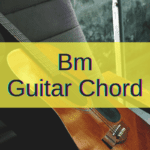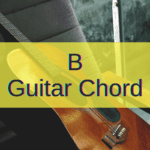Open D tuning for guitars has got to be the most popular open tuning out there.
I mean, sorry about your luck Open E. We do appreciate that you like…exist and stuff.
And while Open D easily lends itself to playing slide guitar, that’s not all it’s good for. It has a deep rich sound that has been used by many musicians.
You may even find yourself wondering why this isn’t considered standard tuning for guitars.
Barre chord shapes are very useful in Open D tuning but you have to be aware of where the root note is in the chord. Also, some of them sacrifice the low bass of the 6th and 5th strings which makes this tuning sound so robust. So I think the more time you spend in the key of D, the better your playing will sound.
Some of the recommended barre chord shapes we’re going to explore are very simple, so they could even be used while playing slide guitar.
And if you are able to finger-pick, this tuning can be a lot of fun too.
Some people might even say that Open D is like Drop D’s big brother.
How do Open D chords work
This tuning is designed to get all of the open strings into either the root, 3rd, or 5th, of a D Major chord, namely, D as the root, F# as the third, and A as the 5th. So playing all of the strings open gives you a lovely chord without even fretting any notes.
Unfortunately, trying to find open chord equivalents for some chords can be very messy.
For example, by its very nature, the open major D chord of this tuning makes minor chords really inconvenient. It’s like the notes that you need are so close but yet so far away: like 11 frets away!
So since most people don’t use this tuning exclusively, the focus here will mainly be on movable chord shapes.
But before you learn the different shapes and try to turn on autopilot mode, make sure that you learn where the root note is as you learn the chord shape.
I think it may be helpful to make an extra effort to remember which finger of your fretting hand is playing the root note as you move a certain chord shape around.
This may sound daunting at first, but it will make more sense soon. Trust me, I think it’s easier than trying to do some of these as open chords
6 Essential Open D chord shapes you should know
Major
All of your major chord keys can be achieved by just barring straight across the strings at the desired root note on the 6th string with your finger, a slide, or a capo. That’s the whole point of this tuning, right bro?
Of course, you can play power chords on the (Drop D) top three strings by eliminating the 3rd note in the scale (F#), or fret notes to change the order of the notes in the chord, but why mess up a good thing?
Minor
A: x 0 2 3 3 2

B: x x 4 5 5 4 or x 5 4 5 5 0


C: x x 5 6 6 5 or 10 10 10 9 x x


D: 0 5 3 3 0 0 or 0 8 7 8 8 0
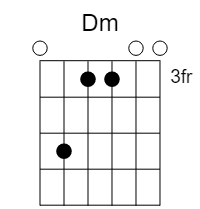

E: x x 9 10 10 9

F: x x 10 11 11 10

G: x 1 0 1 1 0 or x x 0 1 1 0


Dominant
A: 7 7 7 7 10 7 or x x 2 3 4 5


B: x x 4 5 6 7
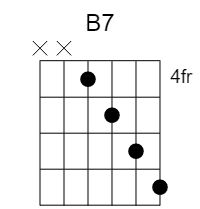
C: x x 5 6 7 8

D: 0 0 0 0 3 0 or 0 0 0 3 3 4


E: 2 2 2 2 5 2

F: 3 3 3 3 6 3
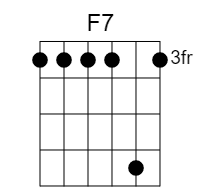
G: 5 5 5 5 8 5
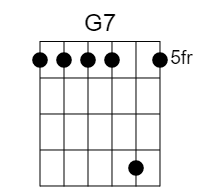
Sus2
A: x 2 2 3 2 2

B: x 4 4 5 4 4

C: x 5 5 6 5 5

D: 0 0 0 10 0 0 or x 7 7 8 7 7


E: x 9 9 10 9 9

F: x 10 10 11 10 10

G: x 0 0 1 0 0 or xx 0 1 0 0


Sus4:
This one is so simple I will only provide the D example of this chord and you can easily use it anywhere on the neck by using barre chords.
The Dsus4 chord frets the F# string on the first fret, making it a G.
If this one sounds familiar it’s probably because this is the same as DADGAD tuning, which is very popular these days.
D: 0 0 0 1 0 0

I have tried to provide a few different options for some of the chords we have covered so far.
But now it’s time to recap and break this down into which ones I think you really need to know.
I will just re-list one for each chord variety as an example of a shape and I will use the lowest possible one (with at least one open string, like an E Major chord in standard tuning).
You can move all the way up the fretboard with these shapes by barring across where the open strings are and playing the proper shape in front of it.
But not all of these chord shapes work the way that you may be used to in standard tuning. Be aware that the lowest note that you usually think of as the root is not always the root of the chords here!
For example, in the G Minor, G7, and Gsus2 chords shown below, the root is on the 3rd string, not the 4th, 5th, or 6th.
I will add in the notes this time to make it clearer, with the root position(s) highlighted.
1. D Major 0 0 0 0 0 0 DADF#AD
2. G Minor x x 0 1 1 0 xxDGBbD
3. D7 0 0 0 0 3 0 DADF#CD
4. G7 x x 0 1 2 3 xxDGBF
5. Gsus2 x x 0 1 0 0 xxDGAD
6. Dsus4 0 0 0 1 0 0 DADGAD
Open D chord progressions
If you want to go by the rules, the chords in a D Major chord progression are as follows:
D Major, E Minor, F# Minor, G Major, A Major, B Minor, C# Diminished.
Most of these you can figure out with the chord shapes we have covered already but since we haven’t explored diminished chords, here is the sixth and final essential chord in this article: C# Diminished.
It consists of the C#, E, and G notes.
7. C#Dim x 4 x 1 4 2 xC#xGC#E

To keep things simple I would recommend trying something based on an elementary Blues music progression first: I IV V IV or something (D Major G Major A Major G Major).
You can start to work in some of the other chords as you get comfortable with this tuning.
Or you don’t have to follow the rules at all and you can just have fun trying things until you find something you like.
Either way, I hope this has at least given you some ideas to start playing songs and maybe even writing some of your own in Open D tuning.

Hello there, my name is Ramiro and I’ve been playing guitar for almost 20 years. I’m obsessed with everything gear-related and I thought it might be worth sharing it. From guitars, pedals, amps, and synths to studio gear and production tips, I hope you find what I post here useful, and I’ll try my best to keep it entertaining also.


